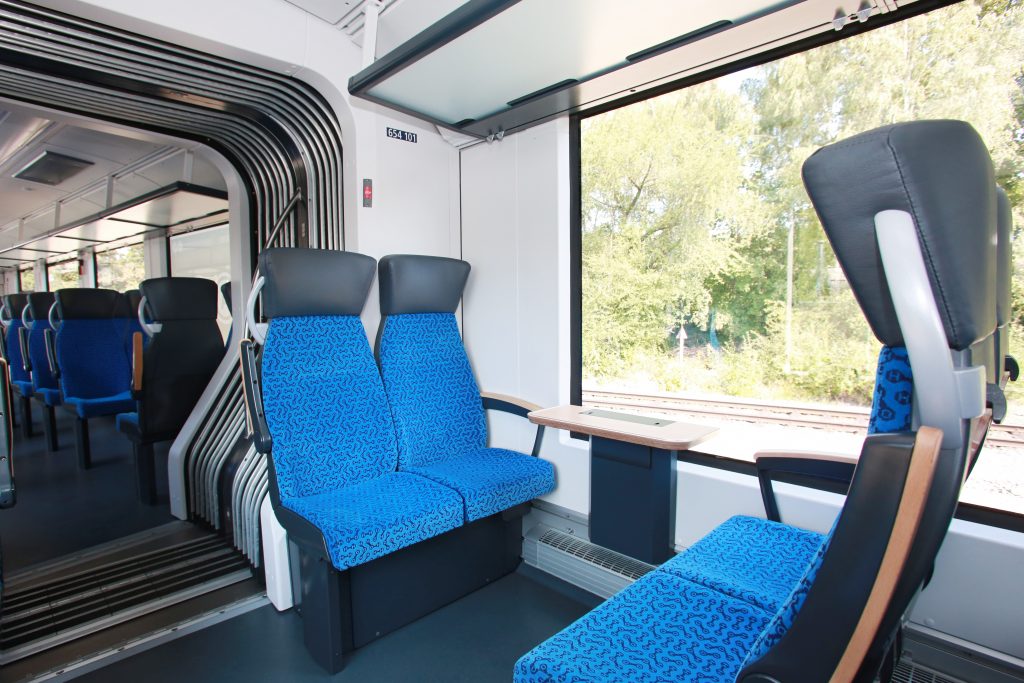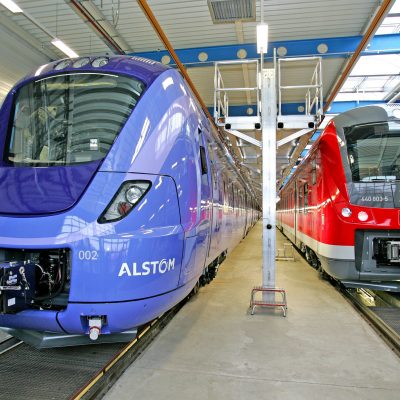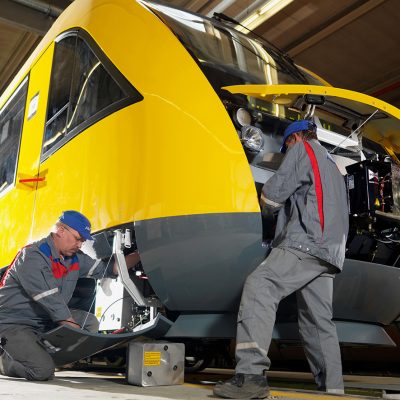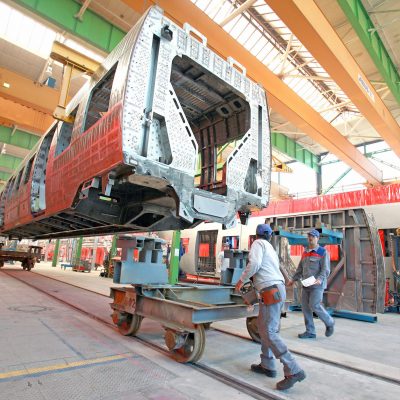I first saw a hydrogen fuel cell locomotive four years ago, at the Stapleford Miniature Railway near Melton Mowbray in Leicestershire. A team from Birmingham University had entered a fuel cell powered one-fifth scale locomotive in the Institution of Mechanical Engineers’ Railway challenge. If someone had told me then that a full-sized fuel cell train would be launched just four years later, and that I would be writing about it, you could have “knocked me down with a feather” (on both counts).
It was therefore quite a surprise to be invited by Alstom to visit InnoTrans in September 2016 to witness a product launch that was widely speculated to be a fuel cell powered passenger train. This visit also included a tour of Alstom’s Salzgitter plant where these trains are being manufactured.
iLint launch
The world is committing itself to targets to reduce CO2 emissions, some of which are tough and with no obvious means of delivery.
It is frequently held that railways are inherently environmentally friendly due to the extensive use of electric trains. However, as the UK has learned, electrification can be very expensive and, increasingly, there are views that electrification might not be viable for any lines other than those attracting significant volumes of traffic. The challenge of significantly reduced or zero-carbon trains on non-electrified lines is therefore likely to remain.
In general, these un-electrified lines are operated by diesel multiple units. Just four countries, Germany, UK, Italy and France (in descending order), operate two-thirds of Europe’s DMU cars, and it is suggested that the annual market value of Europe’s DMU market is some €650 million.
The potential market is significant and Nick Crossfield, Alstom’s managing director for the UK and Ireland, explained that there is a very compelling argument for an electric train that doesn’t require overhead catenary. He added that Alstom has extensive experience with tram vehicles that do not require catenary, and he could foresee a time when catenary electrification would be confined solely to high density or, perhaps, heavy haul routes.
A fuel cell system adds another option to operators to provide high quality transport without the cost or visual intrusion of catenary systems. This, and the political context in Germany (below), led to the development of the Coradia iLint.
Up to now, hydrogen fuel cell proposals have suffered from the lack of ready sources of hydrogen and concerns about performance and range. Is this about to change? We will get to the iLint launch, but, as with most railway issues, the train in isolation doesn’t provide the answer. A carbon-free train requires a system solution, so we’ll start with the infrastructure.
System context
As Alstom’s launch was in Germany with a train for the German market, the German context is as good a place to start as any.
Clearly, any mass exploitation of hydrogen technology will require some sort of infrastructure to provide the fuel to enable relatively unrestricted operation of vehicles. This is usually more than any one organisation can manage. It needs political will to provide the environment and the infrastructure.
Germany has committed to reducing its CO2 emissions by 40 per cent by 2020 (compared to 1990) and to using 80 per cent renewable energy in its power supply mix by 2050. Given that about 50 per cent of German railways are not electrified, the need to reduce diesel operation is crucial if German railways are to play their part in delivering the target reduction in emissions. As hydrogen is a source that allows 100 per cent CO2-free traffic, Alstom signed a Letter of Intent (LOI) in 2014 with four German States (Lower Saxony, North Rhine-Westphalia, Hesse, Baden-Württemberg), and another LOI with one additional region (Calw) in 2015, for the development of a fuel cell train.
But where will the hydrogen come from and how will it be distributed? As part of its commitment, Germany has started to invest in a hydrogen generation plant and hydrogen distribution networks. Whilst these facilities may not yet be developed to permit extensive use, a train refuelling depot located next to a compressed hydrogen pipeline, servicing a captive fleet, is the ideal starting point for trials of hydrogen technology.
Manufacture of compressed hydrogen requires a great deal of energy, which could make hydrogen uneconomic, but Germany has invested heavily in wind turbine technology. As part of its energy mix, Germany is using the energy generated by the wind turbines to make hydrogen when electricity demand is low. This energy might otherwise have gone to waste, so can be regarded as almost free.
As this shows, the infrastructure is gradually becoming available and, because German regional transport authorities are pushing for the implementation of emission-free transport technologies, the scene is set for a truly zero- emissions train.
Andreas Knitter, Alstom’s senior vice-president for Europe, confirmed that Germany, with its Hydrogen Association and some support for development costs, was a good place to explore the benefits in practice.
Alstom Coradia iLint
Henri Poupart-Lafarge, Astom’s chairman and chief executive officer unveiled its zero emission train at InnoTrans on 20 September 2016. This is the Coradia iLint, a hydrogen fuel cell version of the Coradia Lint regional diesel mechanical unit which is available in a variety of configurations from single cars though to three car units.
On the Lint, each car generally has an underfloor diesel engine driving through a cardan shaft onto the adjacent bogie. The fuel tank is provided at the other end of the vehicle and, in between, there is a low floor section for reasonably level access at typical regional stations.
The iLint retains the same mechanical configuration to allow the homologation work to be restricted solely to the changes necessary to gain acceptance of the revised drive train.
The prototype trains will be two-car sets, approximately 54 metres long. On each of the two cars, the propulsion system will comprise:
- Compressed hydrogen tanks on the mid-section roof of each car;
- Hydrogen fuel cell on the trailing end roof of each car;
- A body-mounted AC traction motor and converter;
- A static auxiliary converter to provide power for the train’s systems and a lithium-ion battery pack to store energy recovered during braking, located in the trailing end underfloor space.
Alstom has partnered with experts in fuel cell and battery technology. The fuel cell (from Hydrogenics) takes hydrogen from the high- pressure fuel tanks (Xperion) and combines it with oxygen from the air to produce electricity with steam and water as a by-product. The fuel cell supplies the auxiliary converter, the lithium ion battery pack (Akasol) and the traction converter.
The efficiency of the system relies on the storage of energy in the lithium-ion batteries. Fuel cells tend to work at their best if they are run continuously at reasonably constant performance. The battery stores energy from the fuel cell when not needed for traction and from regenerative braking when the train’s motors turn kinetic energy into electrical energy. In short, the batteries store the energy not immediately required, in order to supply it later, as needed.
During acceleration, the power of the fuel cell will be used mainly to supply traction power demanded by the traction inverter and to supply the on-board systems (via the auxiliary converter), supplemented by power from the battery. The level of fuel cell power depends on the rate and duration of acceleration – short acceleration phases with limited power demand will mainly be supplied by the battery. Only during longer phases of high power demand will the fuel cell operate at full power.
During phases of lower acceleration, constant speed running or coasting, part of the fuel cell power will be used to recharge the battery and to supply the on-board systems. When the battery is fully charged, the fuel cell output will be reduced so that it only supplies the auxiliary converter/on-board systems. This will reduce hydrogen consumption.
During braking, the fuel cells are almost completely powered down. The traction inverter supplies the DC-link with electrical power generated by the motor from the kinetic energy of the vehicle. This power is used to supply the on-board systems and surplus power is used to recharge the battery, a feature that also saves hydrogen.
In service
The specification included a requirement for minimum change from the established Coradia Lint product and that the standard product’s top speed of 140km/h and range (on a single tank of fuel) of at least 600km be retained.
To successfully introduce a new energy source into routine service, a number of changes will be necessary, not least to depot infrastructure and maintenance arrangements. To make the deployment of the fuel cell system as easy as possible for operators, Alstom will be offering a complete package consisting of the train itself, its maintenance and the whole hydrogen infrastructure. This will allow the operator to focus on its core competence while Alstom and its partners take care of all rolling stock and hydrogen-related matters.
During the launch, Alstom officials were confident that, following homologation in 2017, and pre-service trials in 2018, the trains would be in passenger service by 2019. Moreover, they were also confident of receiving a fleet order by the end of 2016.
Testing and homologation will have to demonstrate that all the changes, both to infrastructure and to the trains themselves, meet the requirements that have been set and are safe. Alstom’s engineers will no doubt be considering the risks arising from the introduction of hydrogen (such as sparks during refuelling, or implications for crashworthiness) and lithium ion batteries (possible runaway failures – the launch coincided with the battery problems reported on a well- know brand of mobile phones).
Returning to the conversation with Messrs Knitter and Crossfield, and the cost of hydrogen fuel, readers may be surprised to learn that it is competitive with diesel – at least in Germany. Andreas Knitter added that Germany has an advanced strategy for rolling out the distribution network necessary for its successful introduction.
As for the opportunities for hydrogen in the UK, this was seen as more challenging than in Germany, partly, because the UK is less well advanced in developing hydrogen infrastructure, and partly because the train would have to be a new design, given the need to design for the UK loading gauge. That said, Nick Crossfield confirmed that Alstom is looking for a suitable UK opportunity.
Alstom Salzgitter
Alstom’s largest rail vehicle plant is in Salzgitter, some 68km south east of Hanover. It occupies a site of area 1.2 million square metres, of which 200,000 are occupied by workshops. Approximately 2,500 people work there.
The Salzgitter plant carries out train and bogie manufacture and wagon repair. Alstom’s activity in this part of Germany started in nearby Breslau when Gotfried Linke began manufacturing rail wagons in 1839. The Linke organisation eventually became Linke Hofmann Busch, before partial takeover by GEC Alsthom in the mid-1990s. It was finally wholly absorbed into Alstom Transport Deutschland in 2009.
Production at Salzgitter restarted in 1949 after a period making what were described as “other things”! In 2015, some 150 trains of various lengths were delivered, over 1,000 bogies manufactured and over 3,500 wagons overhauled.
Burkhard Reuter, operations director of the plant, and Christian Wiegand, global planning director for Germany/Austria, showed Rail Engineer around the facility.
The plant currently specialises in regional trains – particularly the Coradia range – Continental, Nordic and Lint. It is also manufacturing the DT5 U-Bahn cars for Hamburger Hochbahn.
Outline descriptions of the products in approximate order of vehicle size are:
- Hamburg DT5 – This is an electric third-rail three-car set. The centre vehicle has two bogies and the end vehicles are suspended off the centre vehicle and mounted on one bogie each. They are constructed from stainless steel, partly unpainted and have open wide gangways through the set. Over 80 of these have been produced in a consortium with Bombardier.
- Coradia Lint – A diesel-mechanical rail car design available as a single car, articulated two- car, bogie two-car or bogie three-car sets. They are steel construction, with an entrance height of approximately 630mm or 810mm above rail. Each car’s power pack is rated at 335 kW or 390kW and they have a top speed of 140km/h. Over 900 trains have been built or are on order. The Coradia iLint is based on this series.
- Coradia Continental – An electric rail car design available as three, four, five or six-car articulated sets. They are steel construction, with an entrance height of approximately 600mm or 800mm and suitable for 25kV, 50Hz or 15kV 16.23⁄ rd Hz electrical supply. Top speed is160km/h. Over 200 trains are in service with nearly another 200 trains on order or in production.
- Coradia Nordic – Based on the Coradia Continental but with a wider carbody to take advantage of the Scandinavian gauge and additional winterisation features for extreme cold weather. They are steel construction, entrance heights are 610mm or 760mm and the top speed is 180km/h. It is currently produced in four and six car articulated sets and for 15kV 16.23⁄ rd Hz electrical supply. Over 300 trains have been built with another 70 trains on order/in production.
The scale of manufacturing plant necessary to build modern steel rail vehicles is impressive. It all starts with steel sheet (bodies) and plate (underframes), cut and shaped precisely and then welded in extensive jigs. Roof sheets are welded flat and then bent and welded to the curved roof frames. Jigs are arranged such that they can be rotated where necessary to allow access for welding to be carried out in the most advantageous way, and some of the welding is carried out in automated plant.
Seeing them side-by-side, it was noticeable that the only significant structural difference between the Continental and the Nordic versions of the Coradia is the flat sides of the former and the curved sides of the latter.
Underframes are necessarily formed of heavier sections than body sides and roofs and the structure on the front end of the end vehicles is even more massive so as to comply with the crashworthiness requirements specified in EN15227.
Once the individual elements have been completed, they are all welded together in a jig and then sent to what was described as the straightening shop which was not visited as it was described as “rather noisy”. This was probably an understatement! In this shop, the vehicles
are adjusted (cue heat and hammers) to correct inevitable distortion during welding. Following this process, the cars shells are sandblasted, inspected and then painted.
The next stage is fit out, using kilometres of cable, great lengths of pneumatic pipes, windows, insulation, doors, traction equipment, compressors, brake equipment, toilets, cladding, pantographs, gangways, floors, seats and luminaires, before the cars are ‘married’ to their bogies. Following that is a static test, and then a dynamic test on the plant’s own electrified test track. The final stage is cleaning and preparation, and then customer inspection.
At the end of the process, a shiny new train, off to carry passengers somewhere in Europe.
Written by Malcolm Dobell
Thanks to Will Roberts, communications director of Alstom UK, for organising the visit to InnoTrans and the factory and to the many Alstom employees who gave their time to support this article.
Photos courtesy of Alstom.






